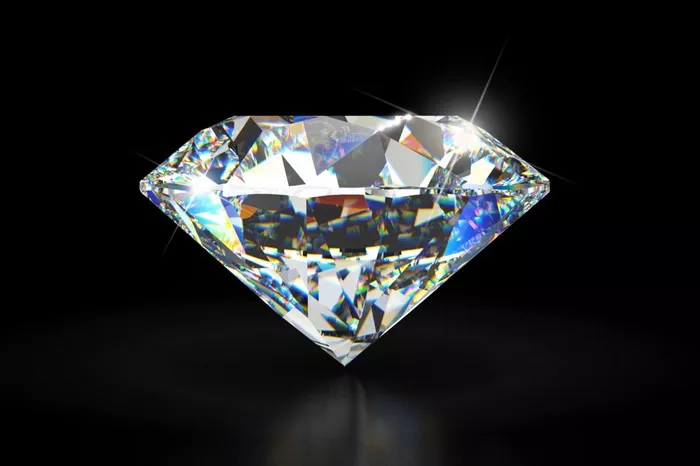When it comes to diamonds, their allure goes far beyond their innate beauty. These gems are renowned not only for their clarity and brilliance but also for their ability to reflect and refract light in captivating ways. One of the intriguing aspects of diamonds is their interaction with light, which leads to the question: do real diamonds reflect color? Let’s delve into the science and artistry behind the mesmerizing play of light in diamonds.
Explanation of Light Reflection and Refraction in Diamonds
At the heart of a diamond’s ability to reflect color lies the phenomenon of light reflection and refraction. When light enters a diamond, it slows down due to the dense structure of the crystal lattice. This reduction in speed causes the light to bend or refract. As the refracted light exits the diamond, it creates a stunning display of colors, known as spectral colors.
This phenomenon occurs because different colors of light have different wavelengths. When light enters a diamond, these wavelengths are separated due to the varying degrees of refraction, resulting in a spectrum of colors being dispersed. This dispersion of light is what gives diamonds their characteristic sparkle and color flashes.
Diamond Brilliance and Fire
In the realm of diamonds, two terms frequently emerge: brilliance and fire. Brilliance refers to the white light reflection observed when light enters and exits a diamond. It is the dazzling brightness that emanates from the facets of a well-cut stone. On the other hand, fire, also known as dispersion, pertains to the colorful flashes or rainbow-like hues that scatter throughout the diamond. While brilliance is a result of light reflection, fire is a consequence of light dispersion caused by the diamond’s refractive index.
A high-quality diamond exhibits a perfect balance of brilliance and fire, creating a mesmerizing interplay of light and color that captivates the beholder’s eye.
Quality Indicators
The reflection of light and the presence of colors within a diamond serve as essential quality indicators. The intensity and distribution of light reflection, as well as the dispersion of colors, are crucial factors in determining a diamond’s beauty and value.
A well-cut diamond with precise proportions and symmetrical facets will effectively reflect light, maximizing brilliance and fire. In contrast, a poorly cut diamond may leak light through the sides or bottom, resulting in diminished sparkle and color dispersion.
Clarity also plays a role in a diamond’s ability to reflect light and exhibit colors. Diamonds with fewer internal or surface imperfections allow light to pass through unimpeded, enhancing their brilliance and fire.
Cut and Polish Influence
The cut and polish of a diamond are paramount in optimizing its ability to reflect light and display colors. The craftsmanship involved in shaping and polishing each facet directly impacts how light interacts with the diamond.
A well-executed cut ensures that light entering the diamond undergoes multiple internal reflections before exiting, maximizing brilliance and dispersion. Conversely, a poorly cut diamond may lose light through improper angles or proportions, diminishing its overall radiance and color play.
The polish of a diamond’s facets also plays a crucial role in light reflection. A smooth, flawless surface allows light to travel unhindered, resulting in a brilliant and vibrant appearance. In contrast, a rough or uneven polish may scatter light unevenly, reducing the diamond’s brilliance and color intensity.
Real vs. Fake Diamonds
Distinguishing between real diamonds and their synthetic or imitation counterparts can be challenging, but understanding their color reflection properties can provide valuable insights.
One common method to differentiate between real and fake diamonds is to observe how they interact with light. Real diamonds typically exhibit strong brilliance and fire, with distinct flashes of color dispersed throughout the stone. In contrast, synthetic or imitation diamonds may lack the same intensity of light reflection and color dispersion.
Additionally, real diamonds often display a unique phenomenon called “fire patterning,” where the colored flashes shift and change as the diamond is rotated under light. This dynamic play of colors is a hallmark of natural diamonds and is challenging to replicate in synthetic or imitation stones.
Furthermore, professional gemologists employ specialized tools and techniques, such as thermal conductivity testing and spectroscopy, to accurately identify diamonds and assess their authenticity.
In conclusion, the captivating beauty of diamonds lies not only in their clarity and brilliance but also in their ability to reflect and refract light, creating a mesmerizing spectrum of colors. Understanding the science behind light reflection and refraction, as well as the influence of cut and polish, is essential in appreciating the unique qualities of these exquisite gemstones. Whether examining a diamond for its quality or distinguishing between real and fake stones, the interplay of light and color remains a timeless fascination in the world of diamonds.

